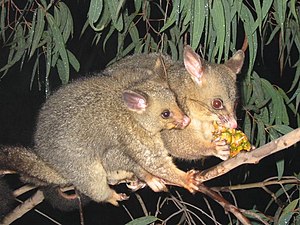Kusus
| Kusus | ||||||||||||
|---|---|---|---|---|---|---|---|---|---|---|---|---|

Fox kusu ( Trichosurus vulpecula ) |
||||||||||||
| Systematics | ||||||||||||
|
||||||||||||
| Scientific name | ||||||||||||
| Trichosurus | ||||||||||||
| Lesson , 1828 |
The Kusus ( Trichosurus , singular of the Kusu ) are a genus of marsupial mammals from the marsupial family of climbers (Phalangeridae). There are four types. They are sometimes referred to as possums , although the term also refers to numerous other Australian marsupials.
distribution
Kusus occur across Australia and on offshore islands such as Tasmania . In addition, they were introduced to New Zealand for fur utilization and now pose a threat to both the native fauna, particularly flightless birds such as the kiwi , and the tree population.
description
Kusus are strong animals. Their body length is 32 to 60 centimeters, the tail reaches a length of up to 35 centimeters. They can weigh up to five kilograms. Their fur is soft and woolly, the color varies from gray to white to brown and black. The ears are triangular and significantly larger than those of the cuscus , the tail is bushy.
Way of life
By nature, Kusus are not as strict tree dwellers as the other climbing baggers. Their natural habitat was forests and other tree-covered areas, but they are also found in parks and gardens in cities. During the day they withdraw in tree hollows, but also in attics and barns, and at night they go foraging. They often come to the ground to forage.
Kusus are loners who mark their territory with scent glands on the anus or on the chest, but in densely populated areas the territories often overlap.
food
Kusus are primarily herbivores that eat leaves, fruits and buds. Occasionally, however, they also devour insects and small vertebrates, such as birds.
Reproduction
Once or twice a year the female gives birth to a single young, rarely twins, after a gestation period of 16 to 18 days. The pouch is well developed, has two teats and opens forward. After four to seven months the youngster leaves the pouch, after six to ten months it is weaned and sexually mature in the 2nd or 3rd year of life. The life expectancy of the Kusu is 10 to 15 years.
threat
Kusus are cultural followers to a greater extent than other marsupials. Since the Europeans landed, their habitat has increased. They are hunted, on the one hand because of their fur (in the fur industry the possum fur is referred to as "Australian", "Tasmanian" or "New Zealand possum fur "), and on the other hand because they often devastate gardens and flower beds, cause damage in young forests and transmit bovine tuberculosis . Even so, they are widespread and not threatened.
species
The cusus are divided into four types:
- The fox kusu ( Trichosurus vulpecula ) is distributed all over Australia except inland. It was introduced to New Zealand for the purpose of fur production, where it has multiplied and is now considered a plague and is being fought.
- The Hundskusu or Bobuck ( Trichosurus caninus ) lives in the coastal areas of southeastern Australia.
- The Cunningham kusu ( Trichosurus cunninghamii ) inhabits mountainous areas in Victoria . It was only discovered a few years ago by statistician Ross Cunningham, who gave the animal its name.
- The Queensland kusu ( Trichosurus johnstonii ) lives in the rainforests of Queensland .
The shed tail kusu , however, does not belong to this genus, but is classified in its own genus, Wyulda .
literature
- Ronald M. Nowak: Walker's Mammals of the World . Johns Hopkins University Press, Baltimore 1999. ISBN 0801857899
- Don E. Wilson , DeeAnn M. Reeder (Eds.): Mammal Species of the World. A taxonomic and geographic Reference. 2 volumes. 3. Edition. Johns Hopkins University Press, Baltimore MD 2005, ISBN 0-8018-8221-4 .
supporting documents
- ↑ Kristofer Helgen & Stephen Jackson: Family Phalangeridae (Cuscuses, Brush-tailed Possums and Scaly-tailed Possum). In: Don E. Wilson , Russell A. Mittermeier : Handbook of the Mammals of the World - Volume 5. Monotremes and Marsupials. Lynx Editions, 2015, ISBN 978-84-96553-99-6 , pp. 482-484.